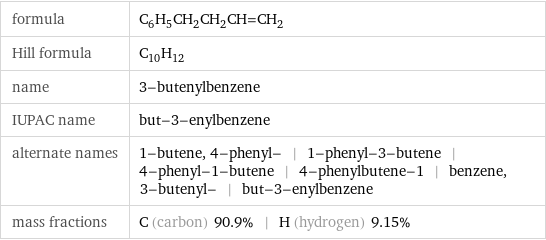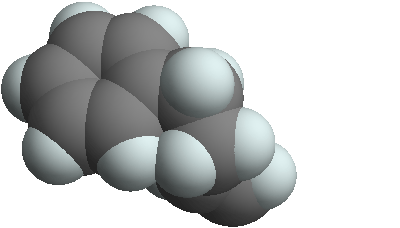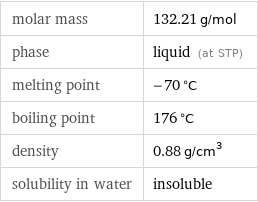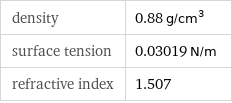Input interpretation

3-butenylbenzene
Chemical names and formulas

formula | C_6H_5CH_2CH_2CH=CH_2 Hill formula | C_10H_12 name | 3-butenylbenzene IUPAC name | but-3-enylbenzene alternate names | 1-butene, 4-phenyl- | 1-phenyl-3-butene | 4-phenyl-1-butene | 4-phenylbutene-1 | benzene, 3-butenyl- | but-3-enylbenzene mass fractions | C (carbon) 90.9% | H (hydrogen) 9.15%
Lewis structure

Draw the Lewis structure of 3-butenylbenzene. Start by drawing the overall structure of the molecule, ignoring potential double and triple bonds: Count the total valence electrons of the carbon (n_C, val = 4) and hydrogen (n_H, val = 1) atoms: 10 n_C, val + 12 n_H, val = 52 Calculate the number of electrons needed to completely fill the valence shells for carbon (n_C, full = 8) and hydrogen (n_H, full = 2): 10 n_C, full + 12 n_H, full = 104 Subtracting these two numbers shows that 104 - 52 = 52 bonding electrons are needed. Each bond has two electrons, so in addition to the 22 bonds already present in the diagram add 4 bonds. To minimize formal charge carbon wants 4 bonds. Identify the atoms that want additional bonds and the number of electrons remaining on each atom: Fill in the 4 bonds by pairing electrons between adjacent highlighted atoms. Note that the six atom ring is aromatic, so that the single and double bonds may be rearranged: Answer: | |
3D structure

3D structure
Basic properties

molar mass | 132.21 g/mol phase | liquid (at STP) melting point | -70 °C boiling point | 176 °C density | 0.88 g/cm^3 solubility in water | insoluble
Units

Liquid properties (at STP)

density | 0.88 g/cm^3 surface tension | 0.03019 N/m refractive index | 1.507
Units

Chemical identifiers

CAS number | 768-56-9 PubChem CID number | 13033 PubChem SID number | 24898267 SMILES identifier | C=CCCC1=CC=CC=C1 InChI identifier | InChI=1/C10H12/c1-2-3-7-10-8-5-4-6-9-10/h2, 4-6, 8-9H, 1, 3, 7H2 RTECS number | EM9000000 MDL number | MFCD00026111
Safety properties

flash point | 60 °C

DOT hazard class | 3 DOT numbers | 3295
Toxicity properties

RTECS classes | other